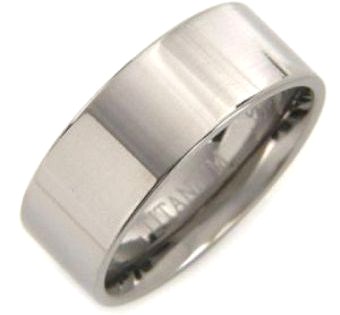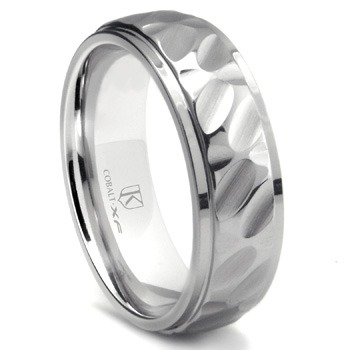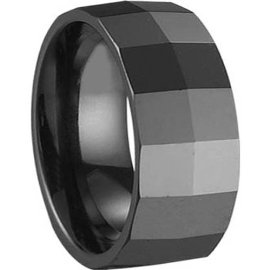My Ring
“With this ring I thee wed, with my body I thee worship, and with all my worldly goods I thee give.”
— Prayer

Gold
Gold (general):
Pure Gold (24K) is yellow and has many unique elements… but is too soft for wedding bands. To make it stronger, pure Gold is typically mixed with Nickel and Copper. The number listed before the “K” denotes the parts (out of 24) that are still Gold. 18 carat (18K), 14K, and 10K are the three best carats of Gold for wedding rings. 14K Gold is the most ideal, because it won’t tarnish as fast as 10K Gold and it’s not as expensive as 18K (the higher the carat, the higher the cost). When mixed with other metals, it can be altered to these colors: white, red, green and rose.

White Gold (specific):
White Gold is man-made from mixing Yellow Gold and various white metals like Zinc, Palladium and Nickel. It has a natural yellow tint, so the whiteness is then enhanced/coated with another metal called Rhodium. Rhodium itself is very white, reflective, extremely hard and virtually tarnish free. Most jewelers can reapply the Rhodium-platting, as desired, for a small fee.

Red Gold (specific):
Red Gold is man-made from mixing Yellow Gold with various metals, including a larger amount of Copper. The more Copper added, the redder it will look.

Image Provided By: Prestige Wedding Bands
Gold Pros:
- A lot less expensive than Platinum
- Stronger and more durable than Platinum (especially White Gold)
- Does not easily tarnish or corrode
- One of the easiest metals to customize
Gold Cons:
- The higher the carat, the less scratch resistant it will be
- Rhodium coating on White Gold will show scratches and eventually wear off, so to avoid that it will need to be reapplied every 6 months to 5 years
- White Gold made with Nickel can irritate the skin
Platinum
Although the first Platinum processing techniques date back to Ancient Egypt (700 BC), it wasn’t widely used until the 18th century. From 1901-1940, Platinum was the metal of choice until World War II. Due to governmental needs, Platinum was restricted from use in jewelry, and White Gold became the new white metal of choice. By the late 80’s, after its removal from the restricted metals list, Platinum began to regain popularity in fine jewelry.
The highest level of purity available in Platinum bands is 95% Platinum and 5% Ruthenium. This particular combination is generally referred to as PLAT or PT950. This indicates the level of purity as required by the FTC (“Plat.” or “Pt.” for Platinum & “950” for the parts per thousand). The addition of Ruthenium also makes it more durable than rings made with Iridium or Cobalt.

Image Provided By: Ritani
Pros:
- Considered the king of all metals
- Naturally white (unlike White Gold)
- One of the heaviest metals (60% heavier than Gold)
- Very durable, and typically outlasts Yellow Gold by many years
- Engravings wear a lot less than on other metals
Cons:
- More likely to scratch and bend
- Maintaining appearance is difficult and costly
- Costs more than Gold because it primarily comes from Russia, which has export restrictions
- Harder to process
- There are fewer mines (about ten Gold per one Platinum)
Tungsten
Tungsten (general):
Tungsten is a very hard and dense metal that is mined from Wolframite ore, and melts at 6,100 degrees Fahrenheit – the highest melting point of all metals. On its own, Tungsten is vulnerable to scratches and damage. When combined with a Carbon Alloy, it then becomes a harder metal called Tungsten Carbide. In this form, it’s four times harder than Titanium, twice as hard as Steel, virtually unscratchable and widely used for cutting tools, mining machinery and rocket engine nozzles. The highest quality Tungsten Carbide combination contains Nickel-Binder Alloy (not Cobalt-Binder Alloy). Nickel-Binder Alloy is superior, because it’s less likely to oxidize, cause rashes or irritate the skin. There is a downside. Tungsten Carbide is a bit more brittle than traditional metals, and may chip or break. Be sure to get a warranty with your purchase. Also, be sure to pick your ring size carefully. Because of its strength, Tungsten Carbide rings CANNOT be sized like traditional metals. Still, your Tungsten ring CAN be cut off if needed.

Black Tungsten (specific):
Under carefully controlled manufacturing conditions, Tungsten’s naturally grayish color can be permanently changed to a rich and luxurious black. The interior is also given a black coat, except for a very thin line used for metal identification. This process also improves resistance to typical wear.

Titanium
Titanium (general):
This common metal is very lightweight, and has a gun-metal gray color like Stainless Steel. The highest quality is Aircraft Grade (6AL/4V) Titanium. Although Titanium is a very hard and durable metal, it can be scratched by abrasive materials like rocks, sandpaper and even Steel tools and utensils. Still, with a little polishing from a jeweler, it should look as good as new. Although a Titanium ring can be cut off, re-sizing these rings is nearly impossible due to its strength and durability. Titanium is also very safe and should not irritate or discolor skin.

Black Titanium (specific):
Using a special Titanium Alloy, the surface color can be permanently changed to a rich and luxurious black. This style of Titanium (Black-Ti) should come with a guarantee to stay black forever.

Image Provided By: Jewelry Vortex
Steel
Stainless Steel:
Known as a low cost metal, Stainless Steel was first used for watches before it was made into rings. It is very durable. If surgical grade steel is used, you should be safe from discolored or tarnished skin. It also continues to look good with very little maintenance.

Image Provided By: Eve’s Addiction
Damascus Steel:
The term “Damascus Steel” has been used to describe an ancient process of making hand-crafted swords by Syrian Artisans over a thousand years ago. Its intricate pattern of Sterling Silver, Platinum, or Palladium is a layering technique that is as individual as a fingerprint. This allows for contrast in its texture and color.

Image Provided By: Andrew's Jewelers
Palladium
This was first used for jewelry when it was declared a strategic metal, and reserved for military use in 1939. Palladium is popular because it’s incredibly durable, won’t irritate the skin, virtually tarnish-proof, more scarce than Gold, whiter than White Gold (never needs to be Rhodium-Plated) and is as white as Platinum but costs and weighs a lot less. It’s equally as rare as Platinum, and the two are mined together in fewer than a half-dozen regions around the world.

Mokume Gane
Pronounced Moe-koo-may Gah-nay, this ancient Japanese metalworking technique was developed in Japan by master sword smiths who wanted to create a stronger sword. The name translates best in English as “wood grain metal,” referring to one of the most popular patterns. Since it is difficult to create, this style of ring is not very common. To construct a Mokume ring, a billet or mold is needed. Several layers of metal (typically 2-4) are then melted together, and manipulated in various ways to take on their final design. Some of the commonly used metals are: Gold, Platinum, Palladium, Silver and Iron.
For an additional cost, these rings can be customized, both in the design and the types/amounts of metal used. The eventual wear of a Mokume ring will depend on the metals chosen. It is not common, but if some repair needs to done, it should only be sent to a jeweler who makes these kinds of rings.

Image Provided By: Gold Works
Cobalt
Cobalt is one of the newest metals to be made into a wedding ring. Although it’s had a variety of uses from ancient sculptors to modern medical devices, it’s low cost, attractive look and toughness make it a popular alternative to more traditional wedding ring options.

Image Provided By: Titanium Kay
Pros:
Affordable price
Brilliant shine like Platinum
Relatively light in weight
Nearly scratch-resistant
Naturally white
Moldable to customize
Hypoallergenic
Doesn’t tarnish
Won’t shatter
Made in the USA
Cons:
Will need to be cut off if it gets stuck
Cannot be resized
Only comes in a bright Platinum like shine
Ceramic
High-Tech Ceramic rings are made using a combination of alternative materials, and are anything but brittle. Because of its durability, this material has a wide variety of uses by engineers in a variety of fields (before its recent use in wedding rings).

Image Provided By: Ceramic Gestalt
Pros
Very lightweight
Affordable
Highly scratch-resistant
Smooth
Glossy look
Durable
Easy to mold
Keeps polished look
No scratching
Hypoallergenic
Highly resistant to chipping
Black color through and through
Many different styles/designs
Cons
May be too casual
Can feel too lightweight
May chip
Cannot be resized

